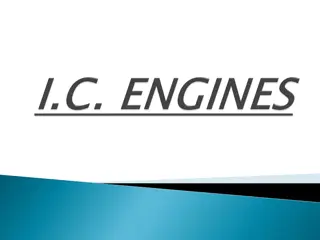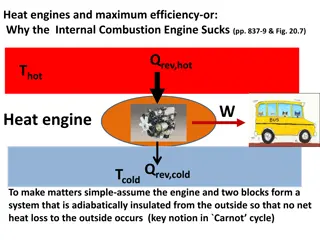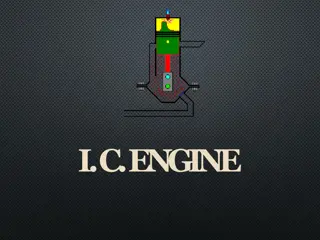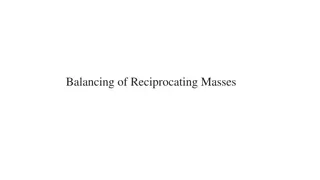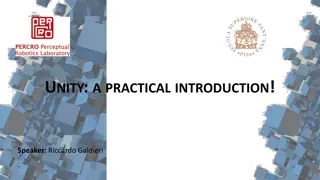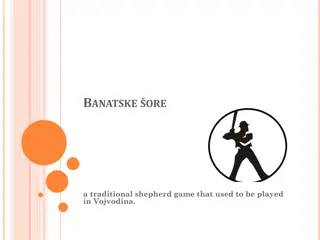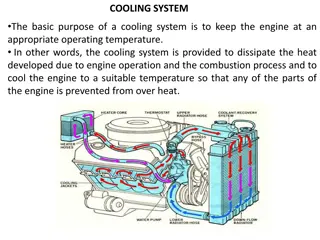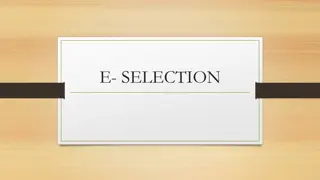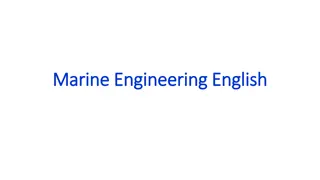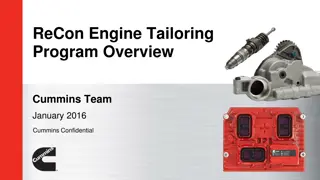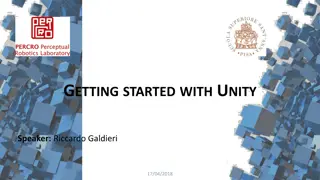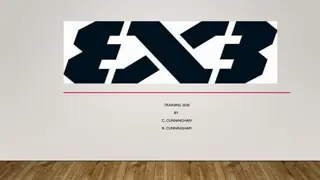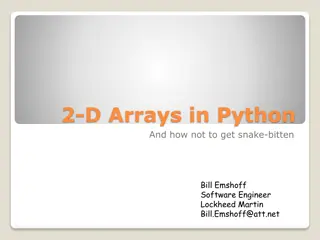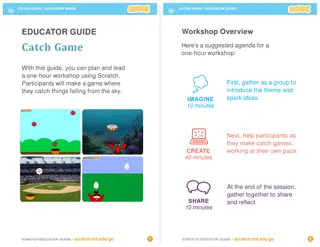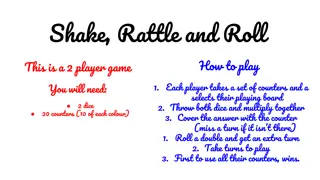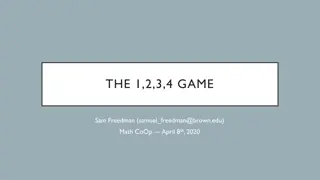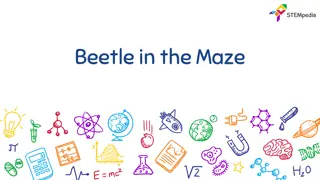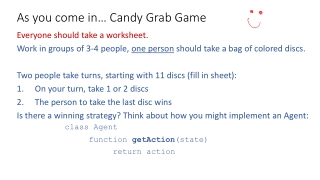Introduction to Game Engines: Why You Should Use One
Explore the importance of game engines in modern game development, their impact on efficiency and cost-effectiveness, and the evolution from manual engine creation to utilizing existing solutions. Learn about the essential considerations before starting a game development project and discover valuable resources for further exploration.
Download Presentation

Please find below an Image/Link to download the presentation.
The content on the website is provided AS IS for your information and personal use only. It may not be sold, licensed, or shared on other websites without obtaining consent from the author. Download presentation by click this link. If you encounter any issues during the download, it is possible that the publisher has removed the file from their server.
E N D
Presentation Transcript
GETTINGSTARTEDWITH VIRTUAL ENVIRONMENTS Speaker: Riccardo Galdieri
How to take this lecture I m not a professor, and I won t tell Prof. Carrozzino anything we say. Therefore, feel free to: Interact, ask (even the dumbest) questions, mess around Record this lecture for personal use (But DO NOT share it) Useful links slide at the end of the presentation, if you want to dive deeper into Game Development These slides will be published (somewhere) online. No need to take notes! If you want to ask any further question, you can reach me at riccardo.galdieri@santannapisa.it / riccardo.galdieri@gmail.com 2
A bit about me... PhD candidate in Emerging Digital Technologies at Scuola Sant Anna Visiting staff at the Breda University of Applied Sciences (Breda, NL) Former Digital Humanities student: BSc in Digital Humanities MSc in Digital Humanities Former King s College London and National Taiwan University student Research interests: Players subconscious behaviours in new environments Procedural ideas generation (ugs.guraas.com) Weighting environmental factors (UI, Narrative, interaction schemes) on UX Impact of real-life events on gaming 3
A bit about me... VR expert (or whatever that means) If you want to work with VR make sure to stick around after your exam! 4
....and a bit about you What s your major? Can you code? What languages do you know? Do you usually play games? What s the last game you played? What platform do you usually play with? 5
On todays menu What is a Game Engine, and why you should use one A bit of history (for nerds) Design your own gam ehm, project What questions you should ask before even starting Applications design pitfalls Useful links and resources at the end of the slides BONUS: let s discuss the projects! 6
PART 1: WHATISAGAMEENGINE? Your project
A long long time ago... In the good old days, for every application programmers had to write a new engine from scratch. It was: Impractical Expensive Time consuming Hardware was evolving too fast to re-use code. Each single application was tailored to make the most of the memory it had. High level languages were still not common. Most of the code (including ALL the GPU drivers) were written in Assembly 8
Script Creation Utility for Maniac Mansion (SCUMM) Created in 1987 (Maniac Mansion) Used by many companies to produce over 50 games: LucasArts (Indiana Jones, Zak McKracken, Full Throttle, Monkey Island) Sierra on-Line (Leisure Suit Larry, King s Quest, Space Quest) Mainly used for graphic adventures! 10
Modern game engines Made by third party software houses They make the engines, not the games They are usually not genre-related, and can be adapted to different types of contents: Bigger market for the producers Can be used to satisfy more artistic views They already implement many modules that may be needed in a game: Programmers only need to develop assets and game logic For all pockets: Can be used by everyone, including hobbysts and universities! 12
Pros of using 3rd party enignes They have communities that can help you! More people => more testers => easier to spot bugs! Reduced costs for the engine development Balancing between the costs of development and the cutout they take is one I wish you to have one day! Are multi-platform They allow you to focus on your own design only! They are artists-friendly! 13
Application design We generalized by saying that you need to feed an engine with your project, but assets aren t everything There are some fundamental questions that need to be answered before even opening your game engine Your project 16
Application design *your project Who & Where Audience & Environment What Code Deadlines Design When Assets How Motivations Why 17
X. When Nine women can t make a baby in a month 18
Managing time in projects As much as we would love to, we don t have infinite time. It is therefore important to manage the time we have in the best possible way. Work expands so as to fill the time available for its completion (Parkinson s Law) It is your responsibility to estimate the time needed to complete a task/project As much as we want you to make nice projects, please don t take two years to develop your application (based on a true story) Having too much time is as dangerous as having no time: Too much time leads to procrastination Not enough time leads to burnouts 19
Deadlines The bigger the project, the less accurate deadlines become: With an average error of 50% (not so unlikely), 6 days become 9 days, 6 months become 9 months. Different factors influence how you calculate your deadlines: How much you know about the software you will use How experimental is the project? Number of people involved in it A wise task schedule can improve your productivity: Use an issue tracker to keep a record of your movements (Trello, JIRA, Mantis) Learn how to control your habits The power of Habit by Charles Duhigg ISBN 9781400069286 Use the pomodoro technique! 20
In one sentence. Make sure to design your project for the time you have, not the other way around. 21
X. What Is a bug or a feature? Yes 22
Getting practical At some point, you have to transform all your design into actual game mechanics What and How are strictly related What should be the skeleton of your application: Software structure Gameplay rules UI design Concept art Interaction design How is the practical implementation of those concepts: Code External data Sprites 3D models 23
Planning phase Once you have built a prototype and tested your drafts, start planning your application accordingly If you have a team of people, it is important to be all on the same page. Professional teams use the so called Game Design Document Old but still nice to read: The Anatomy of a Design Document If the project is small, or the team is, a GDD is an overshoot Set up a one, clear and well defined goal for your application: What are you trying to achieve? Paper drafts can turn out to be extremely useful! 24
Gameplay planning As we already established, every virtual application has a purpose. But translating that purpose into actual gameplay is a different thing At this point you already have a goal and a planned interaction. Transform this concepts into game situations: What do you need in order to achieve your goal? AI? NavMeshes? Special controllers? How do you integrate these things in your environment? What s your architecture structure going to be like? Make sure that YOUR learning curve is balanced with the game difficulty 25
Gameplay planning Lately a lot of people have been asking around how to build an MMORPG. Game Designer Raph Kosher has published a list of what is needed to create an MMO: LINK 26
Software planning If you start to write your application straightaway without planning it in advance, you will fail* Software design is a complex, yet beautiful, discipline. Do not reinvent the wheel and study it: Design Patterns: Elements of Reusable Object-Oriented Software ISBN 0201633612 Familiarize with concepts like Abstraction, Modularity, Refactoring, Information hiding Version control can save your life. Set up one before you even start prototyping Make sure to share coding standards with the other programmers * Unless you are prototyping 27
Graphics planning While code can be explained, graphics can t unless it s drawn Do not underestimate the importance of concept art. Concept artists are responsible to give your application its final look Doing concept art is the most frustrating job in the entire process. 100% of what you do is judged and 95% of it is discarded Basically someone else will discard all of your wor 28
Graphics planning Let s make a little experiment: Think about a tall, male, muscled, bearded character, with tattoos 29
Drafts If something works, you can see it from the beginning A cute character, a main gameplay feature, a particular dynamic Always refactor your code, it will serve you well in the long term period Start showing your project around. People can be a great vector of distribution, and sometimes they can even help you develop it further If your product is too good when you first show it, you ve waited for too long Get good feedbacks as soon as possible Unless they re in the same business, friends will be too nice. Weight accordingly Many people online want to be mean just because they can hide behind the screen 31
In one sentence. Drafts are the foundation of every project. First you design what you want, then you think about how to make it 32
X. How If you know the enemy and know yourself, you will not fear the result of a hundred battles 33
Know your tools It is fundamental to know the tools you are using, and how they can save you a lot of work This should be trivial, but you d be surprised . Keep yourself up to date, not your tools! Follow the latest development of your tool of choice, but please, PLEASE, do not update your version during the final phase. I repeat. DO. NOT. UPDATE. It is your responsibility to make sure that the software used by all the compartments can exchange files Let s see some of these tools 34
Game Engines Unless you are writing your own structure, you will likely end up using a game engine Choosing one is extremely difficult, but the choice matters only as long as you know why you are choosing one over another 35
Some suggestions Asking if you should choose Unity or Unreal is forbidden by the Geneva convention Look at the main feature of your application, and see how it the engine could help you implement it Make sure to know the language your game engine is using Check for fast asset reloading and assets formats Communities can make the difference between one day or three weeks to develop a feature 36
Graphics Unless you are lucky, graphics will be a struggle more than anything else Graphic designer do not have an active role in research, and unless you are planning on earning any money with your application, you may not be able to hire one More than beautiful, graphics must always be coherent. Be careful with: Style all assets should look like they were created by the same hand Definition assets with a lower/higher density really stand out The younger your audience is, the harder the comparison with the industry standard will be People are ignorant about how to make virtual applications, but this doesn t stop them from judging your product 37
Graphics software Unlike game engines, you are not forced to stick to one software only It is common to have certain features on one and not the other Make sure to be able to import your assets into your game engine the way you need to Animations and materials are the usual pains, check them ASAP The number of polygons is not as important as it used to be. The number of batches (Draw calls) is 38
In one sentence. If you know your tools and know your project, design is just transforming your ideas in something concrete 39
X. Why From This is so cool I want to do it to I m telling you to, that s why 40
Project incipit There are many reasons for you to be involved in the creation of a virtual environment: School projects Personal project Enterprise work It is important to adapt your work based on some basic questions: Am I aiming for a shippable project? Is this a prototype of a new concept? Is there a game design document I must follow? How satisfying is this project going to be? Am I learning or just applying my knowledge? Am I involved in the design? Is it my idea? Do I choose the technology? 41
Project incipit SCHOOL PROJECT CASE ENTERPRISE WORK Am I involved in the design? YES NOT VERY OFTEN Is it my idea? YES NO Am I aiming for a shippable project? NO YES Do I choose the technology? YES NO Is there a game design document I must follow? NO (unless .. Nah, no) YES Am I learning or just applying my knowledge? LEARNING APPLYING How satisfying is this project going to be? VERY IT DEPENDS 42
Motivations as part of design Be conscious of your goal. I.E.: If you are prototyping, don t think about code structure, do as fast as possible Weight your project according to your motivation: Intrinsic motivation will serve you well on a longer period of time. If something excites you and you don t feel the weight of doing it, you can plan for a longer period of time. Extrinsic motivation is extremely powerful on the short period of time, but you can easily lose it over time. Great for prototyping, less on the longer period. Keep the number of features as low as possible. Each product has only ONE major feature, everything else is just contour. WHOA, have you seen fallout 4? Best customization system ever! They also have great UI and superb colors! no one ever 43
In one sentence. Always keep in mind why you are working on your project, and design in accordingly. 44
X. Who & Where Programming today is a race between software engineers striving to build bigger and better idiot-proof programs, and the Universe trying to produce bigger and better idiots. So far, the Universe is winning. 45
Know your audience In order to be successful, it is CRUCIAL to know who your audience will be, and where your application will be used As designers, you are responsible for everything that happens around the users. Nothing should happen unless you designed it to Do not build upon stereotypes or common knowledge , but collect data beforehand (if possible) Study how to reach your target. It is pointless to develop any real application if you are not going to reach your audience 46
And know your environment Every virtual application needs a device to be played on. It is important to design your application keeping in mind what the specs of that device are If you can t test your application on every single device, you re playing the Russian roulette Read: keep the number of platforms low! Different people use the same device in different ways Study how your audience engage with the given device Design your application to adapt their use of such devices Test your application with a sample of your audience Repeat 47
And know your environment It is not the environment that tells you how to make your game, it must be you the one that adapts its own game to the environment 48
Data is king A short list of features that might come in hand while trying to identify your audience: Age Gender Native language Cultural background Social background Degree of education Experience with the target subject Familiarity with the designed interaction tools Interest in what you are proposing Let s try to make an example all together 49
Audience needs user experience As designer, you have control over your audience s feelings. There are many things that you can tweak to provoke the feelings you want in a given moment: Colours palettes Sounds and music Choices Dialogues Customization Competition It is always worth to ask yourself if you could gamify your experience Father and son made by the Mann museum is the best example of this 50


